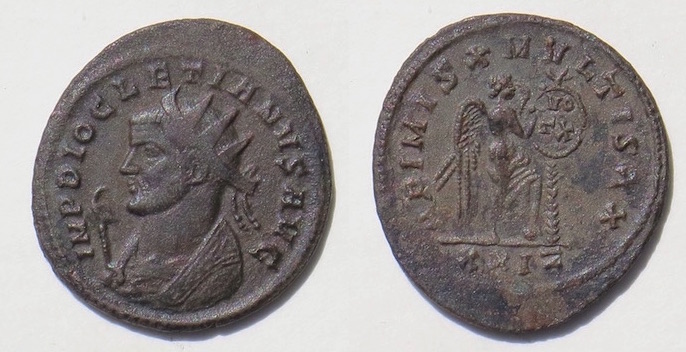
VOTA coins of the First Tetrarchy
Diocletian and Maximian as Augusti with Constantius and Galerius as Caesars.
(Return to the main page on vota coins)
The Tetrarchy. Diocletian (284-305) created the first tetrarchy in AD 293 by creating two Caesars to help the two reigning Augusti. He intended the Augusti would retire after twenty years and the Caesars would become the next Augusti. Vows were taken (suscepta) or paid (soluta) on these occasions. Only a small fraction of the coins minted under the first tetrarchy mention vows, but some reference ten or twenty years and have this connection to history.
Vota coins are not common during the first tetrarchy. They fall into three categories (not counting gold. The rare silver coins do not mention vows):
1) Pre-reform radiates (aureliani, a.k.a. antoniniani). (The first coin below. Also, further below on this page.)
(The big folles from Diocletian's coin reform do not mention vota for emperors of the first tetrarchy.)
2) Post-reform radiates (The second coin below. Also, far below on this page.)
(An issue from Carthage mentions vota for all four tetrarchs for the twentieth anniversary.)
3) Fractional folles, mostly from Trier and all of them rare (The third coin below. Also, a linked page of fractions.)
(Some even mention XXX for Maximian's second reign).
One example from each category is next. Discussion and others of each category follow them.
Pre-reform radiate aurelianus: Chronologically, the first vota coins under the tetrarchy are aureliani (aka antoniniani) struck shortly before the coin reform of 294 for the decennalia (10 years) of Diocletian. At the same time, vows were taken for twenty years.

[Repeated from the main page.]
Diocletian, 284-305
24-22 mm. 3.80 grams.
PRIMIS X MVLTIS XX (First 10, multiplied to 20)
Victory inscribing shield on palm VO/TX
XXIZ in exergue.
IMP DIOCLETIANVS AVG
RIC V.II Diocletian 177H, page 238 "Rome, 293-5"
Vota soluta for ten years and suscepta for twenty.
More aureliani are below.
Post-Reform Radiates: The so-called "post-reform radiate" looks very much like the aurelianus (collectors, and even dealers, sometimes do not distinguish them) but was intrinsically worth much less because it had no silver. Silver is a precious metal which had about 80 times the value of copper by weight and aureliani had c. 4%-5% silver, so they were about four times as valuable as post-reform radiates. The new lower-value radiate coin was accompanied by the new large post-reform "follis" (nummis) with greater value. The new folles did not have vota types.
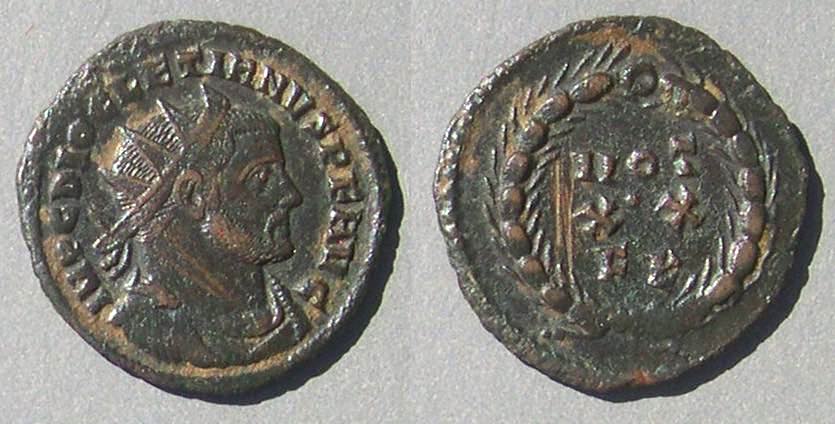
[Repeated from the main page.]
Diocletian, 284-305.
20 mm. A post-reform radiate.
VOT/XX/F K (vows for 20, Felix Karthage)
RIC VI Carthage 37a page 427, struck "c. 303". I think this is wrong. I think it was struck at about the usual time for VOT XX vows, that is, after about 10 years, c. 294-5, shortly after this denomination was introduced. This is discussed further on my page about radiate fractions.
All four tetrarchs have vota coins from Carthage.
The augusti have VOT XX and the Caesars VOT X.
Fractions. Two rare smaller denominations were struck at Trier. Almost all of its types mention vota. Scholars are not certain, but think smaller ones were 1/8 follis, and larger ones 1/4 follis. Here is one of the smaller ones.
 [Repeated from the main page.]
[Repeated from the main page.]
Diocletian, AD 284-305
Struck c. September 303 [both RIC and Zschucke]
14 mm. "1/8 follis"
DIOCLETI-ANVS AVG
VOT/XX/AVGG in wreath
RIC VI Trier 610a.
Zschucke 4.2
More of these vota pieces are illustrated on a page of fractions.
You have now seen one of each category of vota coins for the first four tetrarchs.
To see more vota coins of the first tetrarchy, continue on this page.
To skip to later emperors, continue with coins of Maxentius or here with Constantinian coins.
Return to the main vota page.
Leave the vota pages and go to the Table of Contents of the entire site.
Pre-Reform Radiate Aureliani. The radiate "aurelianus" denomination was discontinued in Diocletian's coin reform of c. 294, so there was little time for the Caesars, elevated March 1, 293, to mint this denomination. The date of the reform is not certain, but the scarcity of pre-reform coins of the new Caesars suggests it was relatively soon after they were promoted. Most tetrarchal aureliani are from Lyons (Lugdunum). Why this is I do not know. [Write me if you do.] For the Caesars all types of aureliani are scarce and none of them mention vota. The denomination is not rare for the Augusti, but all the vota types are all rare.
Vota types for Diocletian:

Diocletian
PRIMIS X MVLTIS XX
Jupiter standing left holding thunderbolt and long scepter, XXIA in exergue
IMP DIOCLETIANVS AVG
RIC V.II Diocletian 175, page 238 "Rome, 293-5"

Diocletian
VOT X M XX
Vows for 10 multiplied (MVLT) to 20
Victory left standing on globe, holding wreath and palm
D in left field, PTR in exergue
DIOCLETIANVS PF AVG
RIC V.II Diocletian 125 Trier "295, R" p. 232
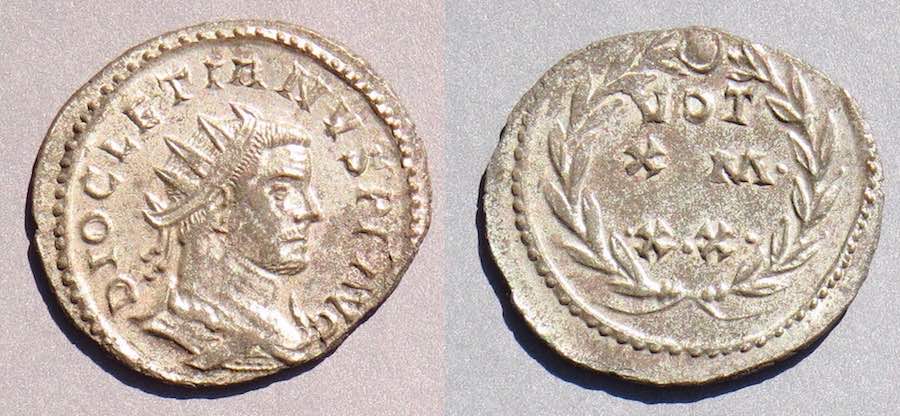
Diocletian
VOT/XM/XX in wreath
Vows for 10 multiplied (MVLT) to 20
DIOCLETIANVS PF AVG
RIC V.II 108, page 230 "Lugdunum, 295". Bastien 677 p.239, 12th emission, 2nd series, no mint mark (294 AD).

[This coin is repeated from above]
Diocletian, 284-305
PRIMIS X MVLTIS XX
Victory inscribing shield on palm VO/TX
XXIZ in exergue.
IMP DIOCLETIANVS AVG
RIC V.II Diocletian 177H, page 238 "Rome, 293-5"
Vota types for Maximian
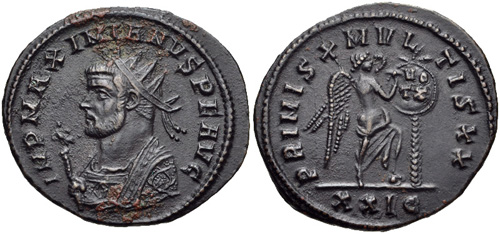

Maximianus
VOT/X M/XX in wreath
Vows for 10 multiplied (MVLT) to 20
RIC V.II Maximian 468, page 273, "Lugdunum, 295"
Bastien 678 p.239, 12th emission, 2nd series, no mintmark (294 AD)

Maximianus
VOTIS X
Two emperors standing face-to-face over tripod
RIC V.II Maximian 467, page 273, "Ludunum, 294"
Bastien 531 p.213, 10th emission, no mintmark (293 AD)

Maximianus
VOTIS X
Two emperors standing face-to-face over tripod
Consular bust left, holding globe
RIC V.II Maximian 467 variety (bust type with globe is not in RIC), page 273 "Lugdunum, 294"
Bastien 530 p.212, 10th emission, no mintmark (293 AD)
Vota type for Galerius:
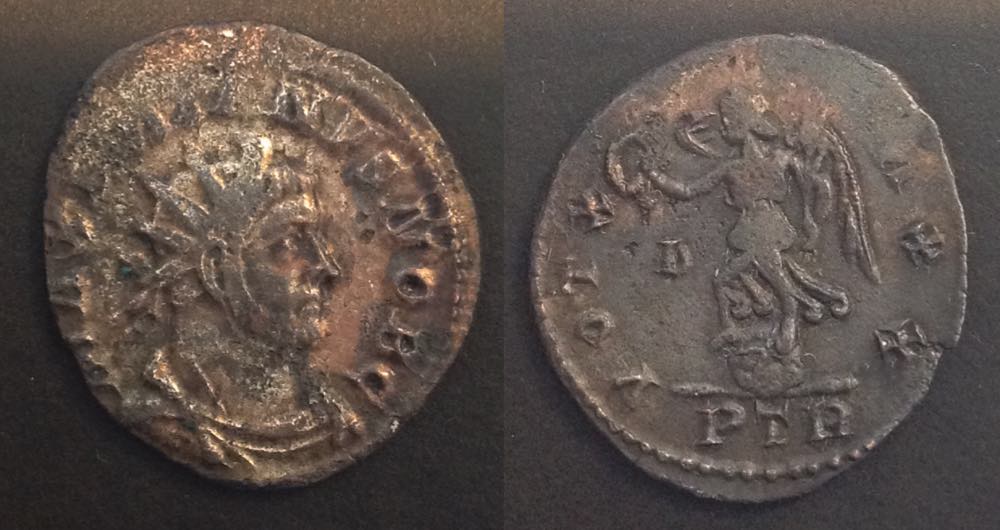
Galerius
23-21 mm. 3.82 grams.
VOT X M XX
Victory left standing on globe, holding wreath and palm
D in left field, PTR in exergue
MAXIMIANVS PF AVG
RIC V.II Galerius 703 Trier "295, S" p. 232
This is the end of the aureliani. Next are "post-reform radiates." (Skip them to go down to fractions of folles.)
Post-Reform Radiates. Most examples are from Carthage or Rome.
Carthage. Under the first tetrarchy Carthage issued post-reform radiate vota coins for the Augusti (Diocletian and Maximian) and the Caesars (Constantius and Galerius) for the occasion of Diocletian's vicennalia (twenty years) in 303.
A note for collectors: All four tetrarchs are available from this issue from Carthage. Vota coins of the first tetrarchy would make an interesting mini-theme collection.

[This coin repeated from above]
Diocletian, 284-305.
20 mm. A so-called "Post reform radiate" without silver.
VOT/XX/F K (vows for 20, Felix Karthage)
RIC VI Carthage 37a page 427.
Next is the same issue from the other Augustus, which is followed by the two corresponding types for the Caesars.
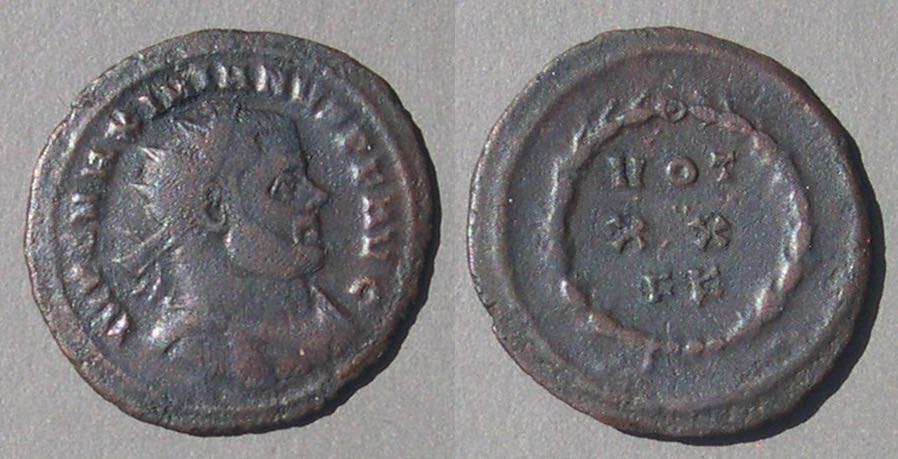
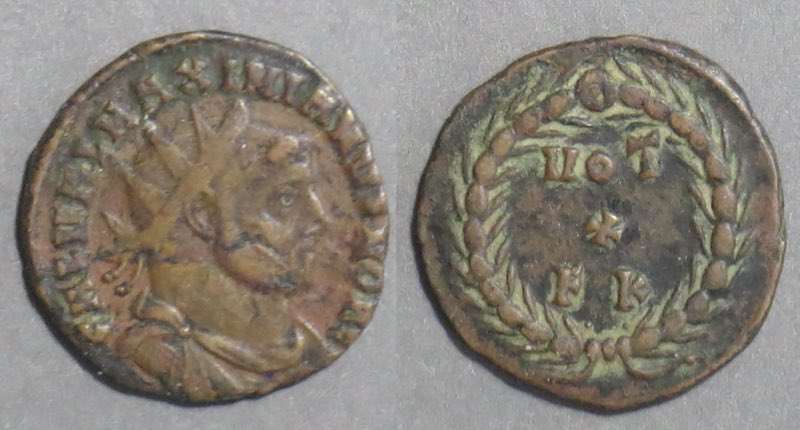 The Caesars of the first tetrarchy were created in 293, so VOT XX for Diocletian corresponds to VOT X for the Caesars.
The Caesars of the first tetrarchy were created in 293, so VOT XX for Diocletian corresponds to VOT X for the Caesars.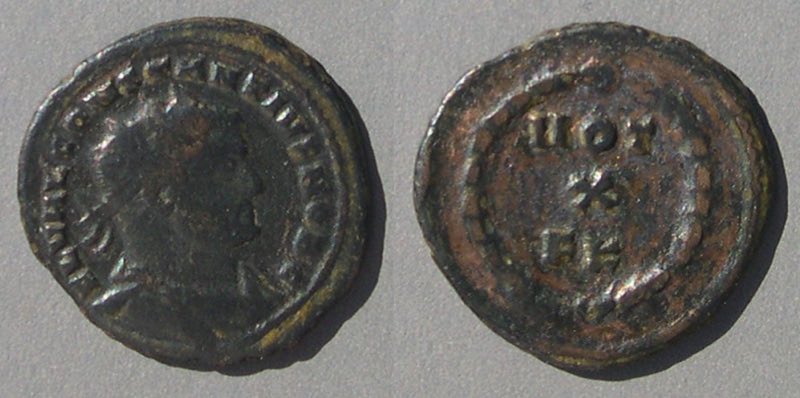 Constantius, Caesar 293-305. Augustus 305-306.
Constantius, Caesar 293-305. Augustus 305-306.
23 mm.
FL VAL CONSTANTIVS NOB C
VOT/X/KF in wreath
RIC VI Carthage 35a. Struck "c. 303." I redate this to c. 294-5.
Failmezger 34 "Rare"
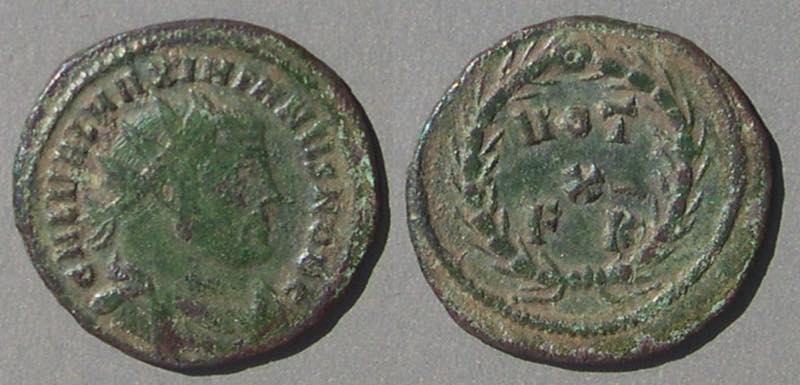
Galerius also became a Caesar in 293.
22 mm.
GAL VAL MAXIMIANVS NOB C, radiate bust right
VOT/X/FK in wreath (vows for 10, Felix Karthage)
RIC VI Carthage 35b "c. 303." I redate this to c. 294-5.
Vows for ten years soluta.
Post-Reform Radiates at Other Mints. Most "vows in a wreath" types under the tetrarchy are from Carthage as above. A few are from elsewhere, mostly Rome, and not dated by RIC to the same occasion even though they are very similar in design.
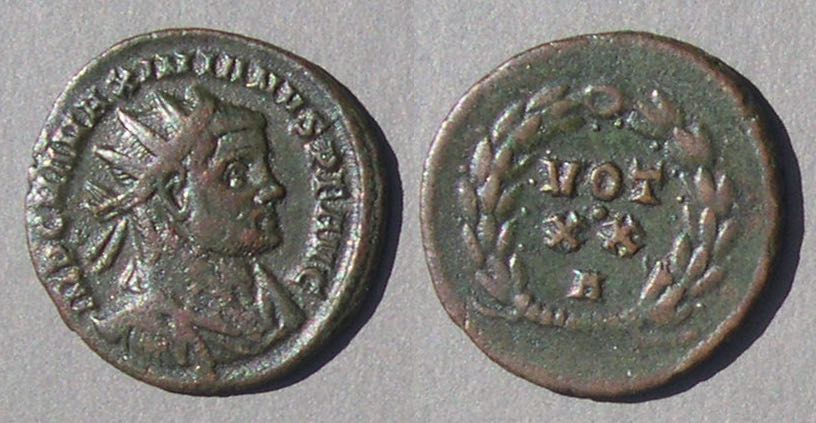 Maximian
Maximian
21 mm.
IMP C MA MAXIMIANVS PF AVG
VOT/XX/A
RIC Rome 75, page 359, "R, 297-298"
"They [the XX pieces] must, then, celebrate (perhaps even with slight anticipation) the half-way mark of the second decennium, .i.e. 297-8." [RIC page 335].
Failmezger 23 "R".
The RIC date does not fit with the usual sort of explanation for "VOT/XX". I think the evidence is that they are not from c. 303 like the similar Carthage types.
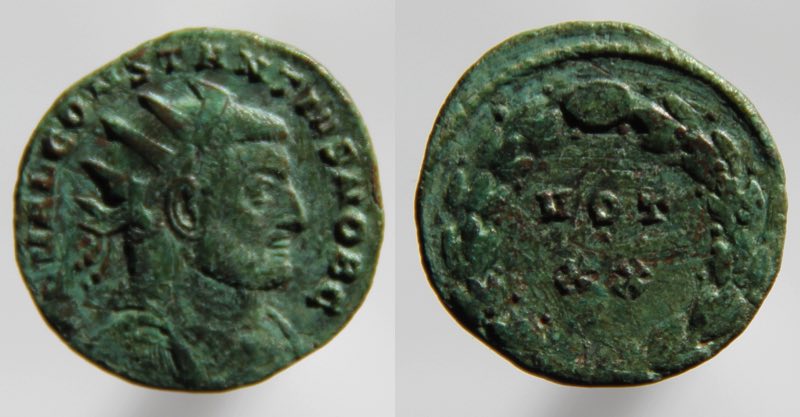
Constantius, 293-305-306
20-19 mm
Struck as Caesar (NOB C)
IMP VAL CONSTANTIVS NOB C
VOT XX in wreath
No visible officina number
RIC VI Rome 87e. "c.297-8." Footnote 2 says some apparently have no officina number.
VOT XX is hard to explain for Constantius with this date. It might be the vows of Diocletian (not Constantius) reconfirmed at year 15 (as proposed in RIC). It might be the coin is really from c. 303 (as the Carthage coins above) and this is vows suscepta for Constantius on the occasion of his ten-year vows. Of, it might be really from c. 303 and the vow number belongs to Diocletian. It is certainly the case that vow numbers can belong to the senior ruler and the the ruler named on the coin.
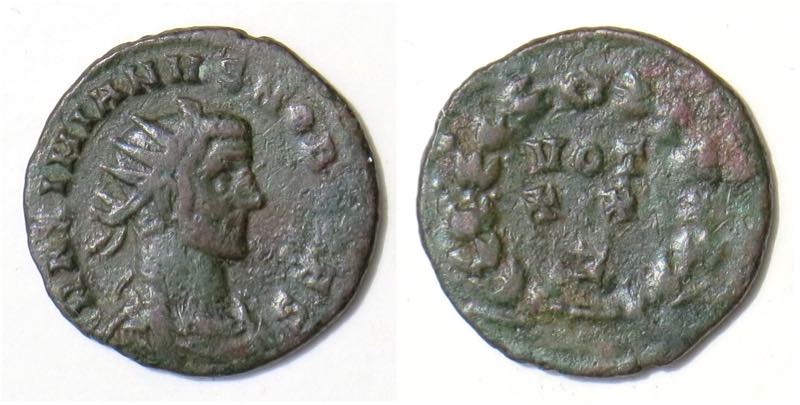
Galerius, 293-305-311
as Caesar, c. 297-8
MAXIMIANVS NOB CAES
VOT/XX/Z in wreath
RIC VI Rome 88B
As with the Constantius coin above, the vow numbers don't seem right for Galerius, for the same reasons with the same explanation.
Fractional Folles. For some unknown reason Trier celebrated anniversaries with issues of rare fractional folles. Most mints did not issue fractions. The great majority of small fractions are from Trier and mention vota. Zschucke lists 263 types from Trier, c. AD 290-321 (including some pieces that are not "VOTA" coins). Here are examples and a link to a page on the "fractions" from Trier.
 [This coin repeated from above]
[This coin repeated from above]
Diocletian, AD 284-305
Struck c. September 303 [both RIC and Zschucke]
14 mm. "1/8 follis"
DIOCLETI-ANVS AVG
VOT/XX/AVGG in wreath
RIC VI Trier 610a.
Zschucke 4.2

Maximian, 286-305 and 306-308. Second reign. Struck for July 25, 307.
14-13 mm
VOT/XXX /AVG in wreath
RIC VI Trier 751
Zschucke 6.7a, this coin
Diocletian intended that when he abdicated after twenty years Maximian would too, so there would not have been an occasion for thirty-years vows had Maximian not rejected the decision and attempted to reassume power. After a falling-out with his son Maxentius he joined Constantine in Gaul, lending the prestigue of a senior emperor to Constantine who had an army, while Maximian did not. These XXX fractions were struck at Constantine's main mint, Trier.
 Maximian, second reign, struck Summer 307
Maximian, second reign, struck Summer 307VO/TIS/XXX
RIC VI Trier 754 page 214 "R, c. summer 307"
Zschucke 7.14, page 48. "1/4, by Constantine in summer 307."
Sometimes this size laureate coin is called a "denarius".
For other vota fractions of the period, see the page on fractions.
The Second Tetrarchy. The story continues with coins issued after Diocletian retired in 305.
Continue with a page on vota coins of Maxentius.
Return to the main page on vota coins.
Leave the vota pages and go to the main Table of Contents page of this entire site.